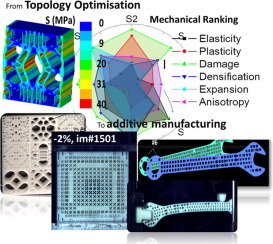当前位置:
X-MOL 学术
›
Eur. Polym. J.
›
论文详情
Our official English website, www.x-mol.net, welcomes your feedback! (Note: you will need to create a separate account there.)
Functionally graded materials from topology optimisation and stereolithography
European Polymer Journal ( IF 6 ) Pub Date : 2018-11-01 , DOI: 10.1016/j.eurpolymj.2018.08.038 Tao Liu , Sofiane Guessasma , Jihong Zhu , Weihong Zhang , Sofiane Belhabib
European Polymer Journal ( IF 6 ) Pub Date : 2018-11-01 , DOI: 10.1016/j.eurpolymj.2018.08.038 Tao Liu , Sofiane Guessasma , Jihong Zhu , Weihong Zhang , Sofiane Belhabib

|
Abstract This work reports an integrated strategy to develop functionally graded materials using additive manufacturing technology. Topology optimisation is exploited to design porous structures with controlled amount and distribution of porosity. Designs are printed using stereolithography and their compression behaviour is determined. Designs are scaled down to form unit cells for functionally graded materials with contrasted mechanical properties. The designed unit cells demonstrate a wide variety of performance, which is achieved when combining topology optimisation and additive manufacturing. The compression performance of designed functionally graded materials exhibits distinctive behaviour depending on the nature and arrangement of unit cells. This study concludes on the high potential of topology optimisation and stereolithography to promote 3D printed designs with property-controlled structures.
中文翻译:

来自拓扑优化和立体光刻的功能梯度材料
摘要 这项工作报告了使用增材制造技术开发功能梯度材料的综合策略。拓扑优化用于设计具有受控数量和孔隙率分布的多孔结构。使用立体光刻印刷设计并确定其压缩行为。设计按比例缩小以形成具有对比机械性能的功能梯度材料的单元。设计的单元电池表现出广泛的性能,这是在结合拓扑优化和增材制造时实现的。设计的功能梯度材料的压缩性能表现出独特的行为,这取决于晶胞的性质和排列。
更新日期:2018-11-01
中文翻译:

来自拓扑优化和立体光刻的功能梯度材料
摘要 这项工作报告了使用增材制造技术开发功能梯度材料的综合策略。拓扑优化用于设计具有受控数量和孔隙率分布的多孔结构。使用立体光刻印刷设计并确定其压缩行为。设计按比例缩小以形成具有对比机械性能的功能梯度材料的单元。设计的单元电池表现出广泛的性能,这是在结合拓扑优化和增材制造时实现的。设计的功能梯度材料的压缩性能表现出独特的行为,这取决于晶胞的性质和排列。



























 京公网安备 11010802027423号
京公网安备 11010802027423号